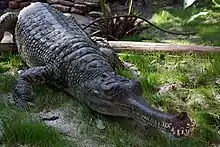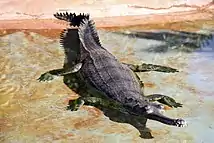Gavialidae
Gavialidae is a family of reptiles within the order Crocodilia. Gavialidae have conventionally consisted of only one surviving species, the gharial (Gavialis gangeticus), which is native to India and Nepal. Many extinct species are also known. The false gharial (Tomistoma schlegelii) has usually been thought to be a member of the family Crocodylidae based on several characters including skull morphology, but has sometimes been viewed as a member of this family due to general similarities in morphology and habit. Numerous molecular studies have consistently shown the two species to be each other's closest living relative, supporting the view that they are in the same family.[1]
| Gavialidae | |
|---|---|
 | |
| Indian gharial, Gavialis gangeticus | |
| Scientific classification | |
| Kingdom: | Animalia |
| Phylum: | Chordata |
| Class: | Reptilia |
| Order: | Crocodilia |
| Superfamily: | Gavialoidea |
| Family: | Gavialidae Adams, 1854 |
| Subgroups | |
Gavialids are large semiaquatic reptiles, resembling crocodiles, but with much thinner snouts. The thin snout is used to catch fish. Gavialids lack the jaw strength to capture the large mammalian prey favoured by crocodiles and alligators of similar size.[2]
Taxonomy
The family Gavialidae was proposed by Arthur Adams in 1854 for reptiles with a very long and slender muzzle, webbed feet and nearly equal teeth.[3] Taxonomists have proposed three different ways to fit Gavialidae members among Crocodilians:
- Palaentologists refer to the broad lineage of gharial-like creatures using the term Gavialoidea.[4]
- If the three surviving groups of crocodilians are regarded as separate families, then the gharial is one of two members of the Gavialidae, which is related to the families Crocodylidae (crocodiles) and Alligatoridae (alligators and caimans).[5]
- Alternatively, the three groups are all classed together as the family Crocodylidae, but belong to the subfamilies Gavialinae, Crocodylinae, and Alligatorinae.[6]
Genera
Family Gavialidae
- Subfamily Gavialinae
- Genus †Eogavialis
- Genus Gavialis
- Gavialis gangeticus, gharial
- Subfamily †Gryposuchinae
- Genus †Aktiogavialis
- Genus †Gryposuchus
- Genus †Hesperogavialis
- Genus †Ikanogavialis
- Genus †Piscogavialis
- Genus †Siquisiquesuchus
In addition, molecular evidence indicates that the tomistomines belong to this group, although morphological evidence has been cited to place them in Crocodylidae:
- Subfamily Tomistominae
- Genus †Gavialosuchus
- Genus †Kentisuchus
- Genus †Paratomistoma
- Genus †Rhamphosuchus
- Genus †Thecachampsa
- Genus Tomistoma
- †Tomistoma cairense
- †Tomistoma? lusitanicum
- Tomistoma schlegelii, false gharial or Malayan gharial
- Genus †Toyotamaphimeia
Species (Extant)
 Gharial (Gavialis gangeticus)
Gharial (Gavialis gangeticus).jpg.webp) False gharial (Tomistoma schlegelii)
False gharial (Tomistoma schlegelii)
† Indicates extinct group
Phylogeny
The phylogeny of gharials is significantly impacted by homoplasy. These endangered reptiles are made up of two different species: Gavialis gangeticus and Tomistoma schlegelii. An important distinction between the two is that under morphological analysis of extant species and fossils, Tomistoma is considered a true crocodile, while Gavialis is not, with the two species' shared characteristic of fish eating being a product of homoplasy. However, molecular data suggests that the gharials are sister taxa, with their shared fish eating trait being a result of homology. Further complicating matters is molecular and morphological data suggesting that the genus of thoracosaurs emerged within the lineage of gharials, despite the fact that the now extinct thoracosaurs actually emerged much sooner than gharials. Lee and Yates conducted a study aiming to combine molecular and morphological methods in order to address this anomaly and distinguish which traits were due to homology, and which were due to homoplasy. They checked living and fossilized crocodiles for a comprehensive list of known traits, and created a supermatrix made up of 10 nuclear genes. The resulting data were analyzed by parsimony and tip dating methods. From their research, they confirmed that the two species of gharials were indeed sister taxa, meaning that the shared traits between Tomistoma and true crocodiles were a result of homoplasy. They also concluded that the only possible explanation for the data placing thoracosaurs within the gharial lineage was a significant amount of homoplastic convergence between thoracosaurs and Gavialis.[7]
Molecular studies consistently and unambiguously show the Gavialidae to be a sister group of the Crocodylidae to the exclusion of Alligatoridae, rendering Brevirostres paraphyletic and Gavialoidea perhaps polyphyletic. The clade including crocodiles and gharial has been suggested to be called Longirostres.[8][9]
References
- Willis, R. E.; McAliley, L. R.; Neeley, E. D.; Densmore Ld, L. D. (June 2007). "Evidence for placing the false gharial (Tomistoma schlegelii) into the family Gavialidae: Inferences from nuclear gene sequences". Molecular Phylogenetics and Evolution. 43 (3): 787–794. doi:10.1016/j.ympev.2007.02.005. PMID 17433721.
- Magnusson, William E. (1998). Cogger, H.G.; Zweifel, R.G. (eds.). Encyclopedia of Reptiles and Amphibians. San Diego: Academic Press. pp. 229–230. ISBN 978-0-12-178560-4.
- Adams, A. (1854). "II. Order – Emydosaurians (Emydosauria)". In Adams, A.; Baikie, W. B.; Barron, C. (eds.). A Manual of Natural History, for the Use of Travellers: Being a Description of the Families of the Animal and Vegetable Kingdoms: with Remarks on the Practical Study of Geology and Meteorology. London: John Van Voorst. pp. 70–71.
- Jouve, S.; Iarochene, M.; Bouya, B.; Amaghzaz, M. (2006). "New material of Argochampsa krebsi (Crocodylia: Gavialoidea) from the Lower Paleocene of the Oulad Abdoun Basin (Morocco): phylogenetic implications". Geobios. 39 (6): 817–832. doi:10.1016/j.geobios.2005.07.003.
- Willis, R. E.; McAliley, L. R.; Neeley, E. D.; Densmore III, L. D. (2007). "Evidence for placing the False Gharial (Tomistoma schlegelii ) into the family Gavialidae: Inferences from nuclear gene sequences". Molecular Phylogenetics and Evolution. 43 (3): 787–794. doi:10.1016/j.ympev.2007.02.005. PMID 17433721.
- Cheng, G.; Gao, Y.; Wang, T.; Sun, Y.; Wei, Z.; Li, L.; Ren, L.; Guo, Y.; Hu, X.; Lu, Y.; Wang, X. (2013). "Extensive diversification of IgH subclass-encoding genes and IgM subclass switching in crocodilians". Nature Communications. 4 (1): 1337. Bibcode:2013NatCo...4.1337C. doi:10.1038/ncomms2317. PMID 23299887.
- Lee MS, Yates AM (June 2018). "Tip-dating and homoplasy: reconciling the shallow molecular divergences of modern gharials with their long fossil record". Proceedings. Biological Sciences. 285 (1881): 20181071. doi:10.1098/rspb.2018.1071. PMC 6030529. PMID 30051855.
- Harshman, J.; Huddleston, C. J.; Bollback, J. P.; Parsons, T. J.; Braun, M. J. (2003). "True and false gharials: A nuclear gene phylogeny of crocodylia" (PDF). Systematic Biology. 52 (3): 386–402. doi:10.1080/10635150309323. PMID 12775527.
- Gatesy, J.; Amato, G. (2008). "The rapid accumulation of consistent molecular support for intergeneric crocodylian relationships". Molecular Phylogenetics and Evolution. 48 (3): 1232–1237. doi:10.1016/j.ympev.2008.02.009. PMID 18372192.
| Wikispecies has information related to Gavialidae. |
| Wikimedia Commons has media related to Gavialidae. |